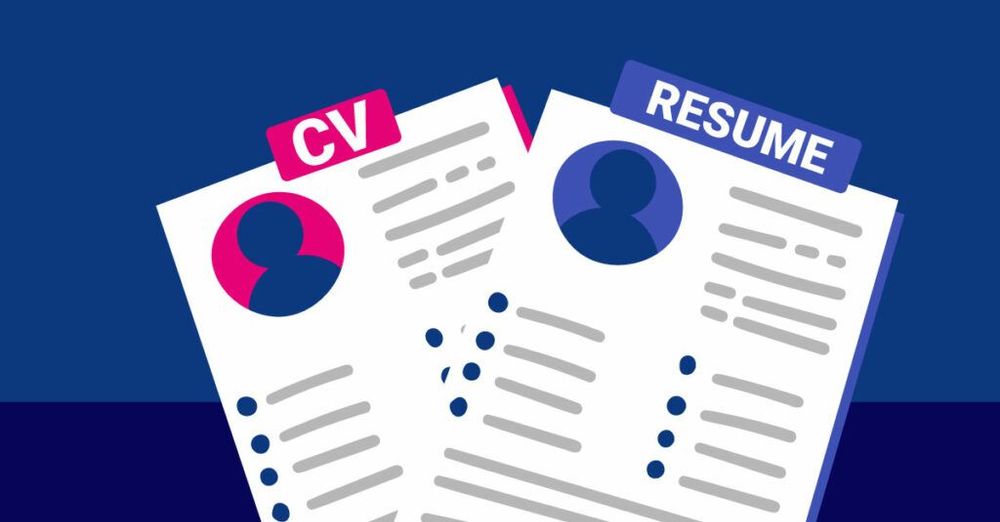
Although both resumes and curricula vitae (CVs) are used in job applications, they are distinct documents with specific differences, even if some employers use the terms interchangeably. In this article, we’ll explore the key distinctions between a CV and a resume, outline what to include in each, and guide you on when to use one over the other. By understanding these differences, you’ll be better equipped to choose and prepare the right document for your job search.
Key Differences Between a Resume and a CV
Though both a resume and a curriculum vitae (CV) serve as job application tools, they differ significantly in length, content, and purpose. It’s important to consider the region you’re applying in, as well as your career path, when choosing which document to use.
In the U.S., a resume is a brief, tailored summary of your skills, qualifications, and professional experience that directly relates to the specific job you’re applying for. On the other hand, a CV is a comprehensive overview of your professional and academic achievements, often including detailed records of research, publications, and presentations.
1. Length
A key distinction between a resume and a CV is their length. A resume is typically one to two pages, focusing only on relevant skills and experience for the role at hand. In contrast, a CV has no length limit and can span several pages, as it includes a full history of your academic and professional background, along with additional details such as research projects, coursework, and publications.
2. Experience and Career Type
Resumes are commonly used for jobs in the private or public sectors, often referred to as “industry positions.” These documents are curated to highlight experience and skills suited to the specific job being pursued. Conversely, CVs are predominantly used for academic, research, or teaching positions, as well as applications for grants, fellowships, and advanced academic programs. If you’re applying for roles within academia or pursuing a master’s or doctoral program, you’ll likely need a CV.
3. Geographic Location
The terminology and usage of resumes and CVs vary by region. In the U.S., resumes and CVs are distinctly different, each serving a unique purpose. However, in places like the UK, New Zealand, and parts of Europe, the term CV is often used to refer to both CV- and resume-style documents, and the word “resume” is rarely used. In countries such as Australia, South Africa, and India, the terms CV and resume are frequently used interchangeably, and their format often resembles that of a resume.
By understanding these differences, you’ll be better prepared to present the right document depending on your career goals and the region in which you’re applying.

When applying internationally, it’s crucial to understand the expectations of different regions beyond just the resume vs. CV debate. In some countries, recruiters may expect you to include a photo, personal details like age or marital status, or even a statement about your visa status. In contrast, in places like the U.S., this kind of information is usually avoided due to anti-discrimination laws.
Always research country-specific norms and consider adjusting the structure and content of your resume or CV to align with local practices, ensuring your application is both professional and culturally appropriate.
What is a Resume?
A resume is a concise document that highlights your career history, skills, and educational background. The word “resume” comes from the French term résumé, meaning “summary” or “abstract,” which reflects the document’s purpose—summarizing your professional qualifications in a brief, targeted format.
What to Include on a Resume
A well-structured resume typically consists of the following key sections:
- Professional Summary: A brief statement at the top of the resume that provides an overview of your career, key skills, and relevant accomplishments. This section should be tailored to the specific job you’re applying for.
- Skills Section: A dedicated space to showcase your most relevant technical and soft skills that align with the job requirements.
- Work Experience: A reverse-chronological list of your professional experience, starting with your most recent position. Each entry should include your job title, the company name, dates of employment, and a short description of your key responsibilities and achievements.
- Education: This section includes your academic background, such as degrees, certifications, or coursework relevant to the role. For recent graduates or those with limited professional experience, education may be positioned near the top of the resume.
- Additional Information: Depending on your background and the position, you might also include sections on professional associations, certifications, volunteer work, or internships. If you lack substantial professional experience, consider highlighting internships, apprenticeships, volunteer work, or personal projects that demonstrate transferable skills.
By tailoring your resume to highlight your most relevant skills and experiences, you’ll create a focused document that effectively communicates your qualifications to potential employers.
What is a CV?
A CV, short for the Latin term curriculum vitae, meaning “course of life,” is a comprehensive document that outlines the full trajectory of your academic and professional accomplishments. Unlike a resume, which is concise and targeted, a CV provides a detailed account of your career, typically in chronological order, beginning with your educational background.
CVs don’t have a set length, and they often span three to ten pages or more, depending on the depth of your experience. The length grows as your career progresses, allowing for a thorough record of your academic, research, and professional milestones.
What to Include on a CV
A CV is far more detailed than a resume and includes a broader range of information. Key sections often include:
- Career History: A comprehensive overview of your professional experience, including job titles, employers, dates of employment, and descriptions of your roles and responsibilities.
- Education: A detailed account of your academic achievements, including degrees earned, institutions attended, and relevant coursework. This section often appears near the beginning of the CV.
- Awards and Honors: List any special recognitions, scholarships, or grants you have received throughout your academic and professional career.
- Research and Projects: Detail any research work or academic projects, especially those related to your field of expertise.
- Publications: Include any books, articles, or papers you have authored or co-authored. Citations should be formatted in a standard academic style.
- Professional References: You may include references from academic mentors, supervisors, or other relevant professionals who can speak to your qualifications.
- Additional Sections: Depending on your field, your CV might also feature sections on professional associations, teaching experience, fieldwork, dissertations, or even a personal profile highlighting key skills and attributes.
By providing a thorough and organized account of your achievements, a CV gives potential employers or academic committees a comprehensive view of your qualifications and expertise.
Resume and CV FAQ
If you’re uncertain whether an employer requires a resume or a CV, here are some key questions to help you decide which document to submit:
What kind of job are you applying for?
If you’re pursuing a position in academia—such as a professor, teaching assistant, or researcher at a university or college—you’ll likely need to submit a CV. Many postsecondary institutions provide specific guidelines for CVs, so it’s important to check the school’s website or ask a recruiter for details before applying.
Where is the company based?
The location of the company can affect whether you submit a resume or a CV. In some regions, like the U.S., resumes and CVs are distinct documents, with CVs primarily used for academic roles. However, in other parts of the world, “CV” might refer to a resume-style document. To determine which to send, consider the job type:
- If it’s an academic or research role, the employer will likely expect a traditional CV.
- For non-academic positions, even within an educational institution, a shorter resume is typically preferred.
If you’re still unsure, it’s best to contact the recruiter or hiring manager to clarify which document to submit.
Should you create both a resume and a CV?
It’s a good idea to have both a resume and a CV ready. While a CV is a more detailed version of a resume, transforming one into the other isn’t overly difficult—it’s just a matter of adding more comprehensive information to the CV format. Keeping both on hand ensures that you’re prepared no matter what the job posting requests.
Having the correct document is essential for job applications, and being well-prepared can make all the difference in standing out to employers. At Debut Careers, we provide resources to help you craft the perfect resume or CV to enhance your job search and position yourself for success.


